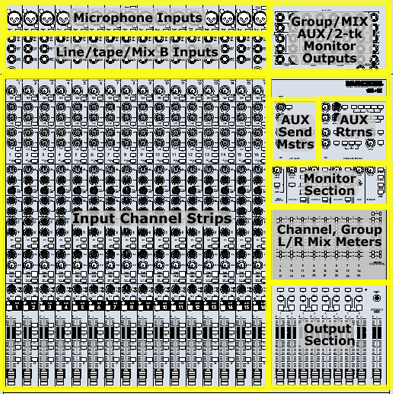Chapter Two: Studio Gear

4. Mixing Consoles
A mixing console is used for a wide variety of purposes in a computer music or audio recording studio. It is also almost always used in live sound and concert playback situations, and so electronic composers should try to familiarize themselves with boards and mixing principles in general. Fortunately, whether they are digital or analog, they are all built around similar frameworks, even if they are virtual and on a computer screen as part of a DAW.*
Mixing consoles are often classified by their input and output (I/O) capabilities. For example, a 32 x 8 mixer would have 32 individual channel inputs and eight main output channels. Most professional boards have many more input and output capabilities besides the main I/O's. In addition, boards can serve as signal routing devices, moving audio signals from one device to another.
Digital mixing consoles, once reserved for very expensive commercial studios, have become much common for smaller studios as well. These boards handle not only analog signals from devices like microphones, but also mix analog and digital signals with each other from devices such as synths and computer audio interfaces. Such device specifications, in addition to the basic number of channels, include digital I/O terms such as AES/EBU, TDIF, Lightpipe/ADAT, S/PDIF—all different forms of digital connection and transmission protocols.
Most digital boards, some analog boards, and virtual all DAW software mixers have some form of mixing automation, where predetermined movements of faders, equalization, effects sends and panning are often sync'ed to audio tracks or time code, and can be rehearsed and modified. Back in the day, these were often called flying faders. Before that, one might need to get a bunch of friends and use a stop watch to time manipulation of all the possible controls needed for a complex mixdown. Digital boards are often highly configurable, where various patches change the function of each input or output channel at the touch of a button.
The image below indicates the layout of the various section of a typical mixing console, in this case, a Mackie 8-bus analog board. Each of the sections below will be examined individually in the next several pages.
